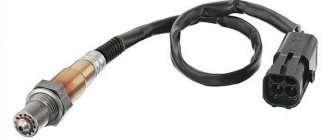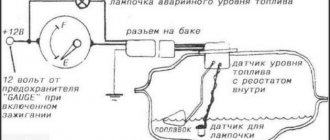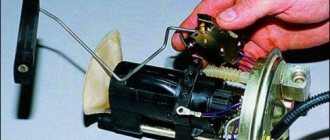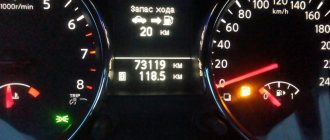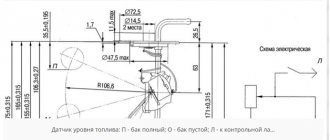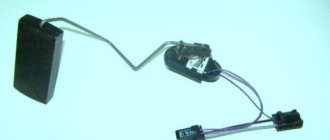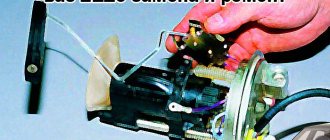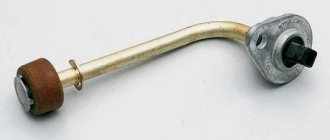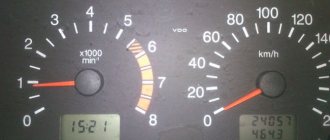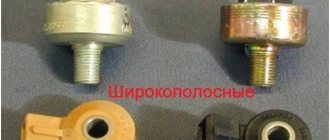It becomes extremely inconvenient to operate a car if the fuel level indicator on the dashboard is lying or not working. To avoid getting into a hopeless situation with an empty tank, the driver has to record the odometer readings and calculate the approximate mileage based on fuel consumption. Another option is to constantly carry a spare canister filled with gasoline or diesel fuel in the trunk. Getting rid of these inconveniences is a trip to a car service center or self-diagnosis and troubleshooting.
What to do
First you need to carry out diagnostics, that is, find out which part is damaged - the sensor, wiring or the indicator itself. For this, a regular multimeter is used, but you can replace it with a test lamp.
First you need to gain access to the fuel section and the fuel level sensor itself. To do this, with the car running, you need to remove the connector in the service hatch under the rear sofa of the car. Then, using the electrical supply diagram, you need to determine which wire goes from the sensor to the fuel indicator. One connector of the multimeter must be connected to the ground of the car, the other to the positive terminal of the wire coming out of the hole. The multimeter should show the on-board voltage (12 V). If you close the positive terminal to vehicle ground, the indicator arrow should show a full tank. If this does not happen, the wiring or the indicator itself is to blame. If the needle shoots up to the extreme position, the problem is in the fuel sensor.
Modern fuel sensors are best replaced as an assembly. Their price is not so high as to make repairs that do little to help the business. However, in some cases, you can try to clean the sensor from dirt and try to adjust the slider. To do this, you will have to remove the sensor (you must first drain the fuel, turn off the car and remove the negative terminal from the battery). After removing the sensor, you need to inspect the working surface of the sectors for wear. If the width of the wear line is small, you can adjust the slider so that it moves along the undamaged surface of the sectors.
If incorrect readings of the fuel level indicator are not associated with the fuel sensor, then you will have to remove the indicator from the dashboard. Wiring problems can also be diagnosed using a multimeter. The malfunction of the device itself is determined manually after removing the device - if the arrow is jammed, you can try to clean it and adjust it.
Fuel level sensor does not work
The FLS, like any other elements of the car, can systematically fail, resulting in the need for repair work. Now we will take a closer look at the most common causes of this phenomenon:
- If the FLS readings are constantly changing (“jumping”), it is possible that the contact tracks on the board are worn out, which are erased under the influence of time as a result of the device’s slider constantly moving along them. If the worn area is not large, try bending the slider so that it is located above the worn area; however, if the worn area is large, the problem can only be solved by replacing the sensor.
- It happens that when the fuel tank is full, the indicator arrow of the sensor returns to zero. A possible cause of this phenomenon is an incorrectly placed float stop.
- When the engine is running and the ignition is on, the indicator arrow remains stationary. As a rule, the reason lies in damage to the connecting wires, oxidation of their tips, a malfunction of the pointer receiver or a blown fuse.
- If the fuel level indicator needle constantly drops to zero and also twitches, you should check the current collector; it is probably not touching the sensor resistor enough, or the winding of the resistor has broken.
- In addition, the warning lamp about the minimum fuel level in the tank may stop working altogether or work incorrectly, intermittently. In this case, most likely the problem lies in the resistor and you may have to replace it.
The most common problem with potentiometric sensors is their rapid wear, as well as oxidation of the tracks, which determines the appearance of the problems described above.
We recommend: How to determine the wear of winter tires?
How does the device work?
To understand the problem yourself, you need to understand how the fuel level is measured and information is transmitted to the device indicator. The circuit implemented in most vehicles includes the following main elements:
- a float made of lightweight polymer is immersed in the gas tank and is often combined with the pump block;
- gasoline sensor – lever-type potentiometer (otherwise known as rheostat);
- pointer arrow with scale;
- connecting wires.
In many modern cars, an electronic control unit is connected to the system.
The classic rheostat is an open coil of high resistance wire. A lever equipped with a contact and attached to the float rises or falls with the level of fuel in the tank, and the contact moves along the turns of the winding. The classic scheme works simply:
- The rheostat and the pointer device are connected in series in the circuit, both are powered from the vehicle's on-board network.
- When moving the float with the lever, the resistance of the potentiometer changes.
- A change in resistance causes an increase or decrease in the current in the circuit, to which the indicator arrow reacts. The scale is graduated according to the resistance values corresponding to the filling of the gas tank.
The updated version of the system works with the participation of a controller. The fuel level arrow receives a processed digital signal from the electronic unit that supplies power to the potentiometer. The principle of operation does not change, but the circuit allows you to obtain more accurate readings.
Possible problems with the fuel level sensor
The operation of a car is accompanied by breakdowns of many components and assemblies, and the sensor that monitors fuel consumption is no exception. Violations in its operation can be manifested either by a complete failure or by errors in the information provided.
Malfunction in indicators
The following signs will allow you to timely identify malfunctions of the fuel control unit:
- the fuel level indicator arrow is not static, it is in constant motion, twitches, and can jump;
- when confidently refueling “to a full tank”, the fuel level indicator will show a partially filled or empty tank;
- when the engine is running, the needle does not deviate to the actual level of gasoline (diesel), but is in its original position;
- The problem may look like the warning light not warning you that the fuel level is extremely low.
Diagnosis is always necessary. In some cases, for example, if the indicator does not respond to starting the engine, it is possible that a fuse has blown or a loss of contact on one of the supply wires (checked by a tester); in others, the fault should be looked for in the mechanical part of the sensor.
Mechanism malfunction
Incorrect operation of the sensor mechanism may be due to the following reasons:
- The float lost its tightness, and fuel entered the internal cavity. In this case, regardless of how full the tank is, the sensor will inform you that it is partially filled or there is no fuel. The malfunction is eliminated by replacing the float or the entire control unit.
- Violation of the geometric shape of the wire holder. It will affect the mobility of the float, and the devices will begin to act up. Deformation occurs when the car is used for a long time on an uneven road or in rough terrain, as a result of which a shock load is applied to the mechanism. Troubleshooting is represented by returning the holder to its original shape.
- Damage to the device body, accompanied by a drop in resistance. This occurs during long-term operation using low-quality fuel, regardless of whether it is an injection or carburetor engine, or shock loads in accidents. In this case, the readings of the control indicator will take the position of the maximum filled tank or be in the “zero” position.
- Failure of resistive elements. Control devices will lie in the same way as in the above case. The device will deceive until the unit is completely replaced.
- Failure to attach the sensor to the vehicle tank. The consequences are presented by why a characteristic gasoline or diesel smell of fuel is felt in the interior and trunk of the car.
Important! Periodic control inspections of the condition of the electrical wire contacts and the reliability of the sensor fastening resolve the issue of timely detection of a malfunctioning tank fullness monitoring system.
Replacement process
In order to replace the FLS, you will need a 7 key and a 17 socket. Before starting work, you should make sure that there is practically no fuel left in the tank. Relieve the fuel system pressure and turn off the power to the fuel pump. After that we start the car. The engine should idle until the fuel runs out and the car stalls on its own. When the fuel runs out, you can start disassembling it and be sure that it will not get into the car interior.
We use a Phillips screwdriver and unscrew the hatch cover in the car. The wires must be disconnected from the pump. Using a key set to “17”, unscrew the fuel line tube and put it away. It is necessary to check the ring that is located on the fitting; if it is damaged, replace it. Similarly, disconnect the drain tube.
We use a 7 socket to unscrew the bolts that secure the pump using a clamping ring. We disconnect the pump and inspect the rubber ring; if it is damaged, replace it. Afterwards we unfasten the screws and turn off the sensor. We install a new parting in the reverse order.
Types of fuel level sensors
Before considering the question of how to check the fuel level sensor, it is worth studying what types of such devices there are. Modern sensors are characterized by a certain number of advantages, among which are:
- reliability, accessibility and simplicity of design;
- high levels of measurement accuracy;
- low cost.
Among the disadvantages is the presence of built-in elements that are susceptible to frequent breakdowns due to oxidation.
The fuel system of modern cars uses devices of two main categories - lever and tubular. The main similar element of such devices is the float. For their manufacture, thin sheet metal, foam and hollow plastic are used. The remaining details of these devices are somewhat different, so each type must be considered separately.
Lever type
Such devices consist of a potentiometer, a float and a lever. The float is connected to the sensor contact via a small lever made of high-quality metal. By their design, sensors of this type are a sector divided into strips of metal of a special resistive type.
Such sensors can be mounted separately or in the unit itself responsible for fuel supply. Thanks to this versatility, the sensors can be used on almost all types and categories of fuel tanks.
Tubular type
In this sensor, the float moves inside the hollow part of the tube. There are also special wires that create a certain resistance. At the ends there are slip rings for the included float. Among the main features of such a device are:
- High level of resistance to vehicle vibrations.
- The main element is completely enclosed, which protects contact with the fuel being used.
- The float here is connected to the lever via a magnet.
The magnet moves along a sector where metal plates of different lengths are installed. The generated magnetic field creates a special electronic signal that determines the current level of the fuel mixture in the fuel tank at the time of measurement.
We recommend: How to unscrew the oil filter without a key?
Common problems
The fuel volume control system in the gas tank is susceptible to the following malfunctions:
- the pointer indicator lies at zero regardless of the amount of fuel remaining in the tank;
- the device does not display the fuel level correctly - it is lying up or down;
- the needle “jumps” or changes readings in a short period of time;
- The yellow minimum fuel indicator indicator does not light up.
Reference. In some domestic car models, the fuel sensor is lying from the factory. An example is the Chevrolet Niva SUV of the first releases, where the device greatly underestimates the actual level of gasoline. The driver, guided by the sign, pulled into a gas station, only to discover that the tank was full to the top.
There are several reasons why the needle drops to zero:
- Sticking or jamming of the lever.
- The float lost its seal and sank to the bottom.
- An electrical circuit is broken due to oxidized contacts or a wiring problem.
- Failure of the indicator itself or the lever sensor - potentiometer.
Typically, incorrect readings and “jumps” of the needle are a consequence of contamination of the rheostat and slider. On a car with high mileage, these parts can wear out - the thin layer on the plates wears away, causing contact to disappear between them and the runner.
The fuel level sensor in the tank sends conflicting signals that are reflected on the dashboard.
One of the reasons for the minimum level indicator not working is a burnt-out light bulb on the instrument panel. Less common are problems with the end contact located inside the tank, or a break in the electrical wiring. In the newest systems, the lamp even lights up at the command of the controller when the resistance of the lever potentiometer reaches a certain value.
Adjusting the readings
If the arrow periodically increases and decreases the values, then adjustment will help in this case.
Adjusting the fuel sensor (FLS) - removing the fuel pump
If in any position the arrow indicates incorrect values, then it is necessary to bend the adjusting tongues on this side so that the float rod can move to the right or left freely, depending on its location.
Adjusting the control arrow on the instrument panel
If the problem is the arrow on the instrument panel, then you need to remove the instrument panel and adjust it manually.
How to prevent the problem
It is almost impossible to prevent sensor damage, since mechanical wear of the sectors or float is an absolutely natural phenomenon. Therefore, if the indicator needle begins to behave strangely, and the check reveals problems with the sensor, it is better to replace it as an assembly, fortunately its price is not very high.
The same statement is true if the indicator itself breaks down. Service work to prevent damage to this device is not provided - only replacement if a malfunction is detected. Problems with electrical wiring, including a break in the wire leading from the fuel level sensor to the indicator, can also be solved by replacing the wire.
Fuel level sensor - device (FLS)
In this article, our attention will be focused on cars where the FLS is used to indicate the fuel level, convert this level into volume and transmit the resulting value digitally or analoguely.
This device consists of a metal rod mounted into the fuel tank through a standard hole or a specially made hole of suitable diameter. The sensor is connected to the vehicle's monitoring system, where the required data is transmitted.
They are often high-precision universal devices, which allows them to be used not only in transport, but also in other equipment, and even in stationary facilities - factories, warehouses. This unit is closely interconnected with the fuel level indicator located on the instrument panel.
Today, there are a number of FLS variations - universal, ultrasonic, float, digital, electronic, but their common goal is the same - to correctly determine the fuel tank consumption, so that every driver has the opportunity to control their fuel costs. In addition, the device makes it possible to monitor the amount of drainage (the most useful option for taxi services, business managers and other organizations in which employees are able to drain government fuel) and fuel refills (in what volume, when and where they were carried out).
To be able to monitor the fuel level in more detail, it is necessary to install an appropriate device on the car with minimal error and increased sensitivity, which will provide the most accurate readings.
connecting the fuel level sensor
There are two methods for connecting the FLS to the vehicle’s on-board network, the design of which includes a ground switch:
- Connecting the FLS to the on-board network after the main switch. The sensor, in this case, will be de-energized immediately after the vehicle's mass is turned off. In this case, it will be impossible to find out the drain time when parked - the sensor will be turned off. This connection method is recommended for cheap sensors where there is no galvanic isolation.
- Connecting the sensor to the battery directly. This connection method is ideal from a practical and functional point of view. In addition, connecting the FLS directly to the battery is safe, since the sensor current consumption is only 10-48 mA. It is recommended to connect Pro Sensor sensors directly to the battery, since they are distinguished by the presence of a built-in galvanic isolation of up to 3000 V. In addition, the polymer body of this sensor is an insulator, as a result of which all electrical circuits are reliably protected from electrical breakdown. To connect other sensors directly to the battery, you will have to install additional galvanic isolation.
General information about the sensor
First, let's look at the main features of the FLS:
- In the first year or several years, the device works normally and can perform all the functions assigned to it. But since the VAZ 2115 fuel level controller itself has a rather fragile body, regular temperature changes, especially in winter, help reduce its service life.
- The car owner must periodically diagnose the regulator, since over time its tightness begins to deteriorate. Accordingly, at a minimum, it is necessary to clean the contacts from oxidation from time to time. If the contacts begin to fray, you can simply replace them.
- The choice of a new fuel level regulator for a VAZ is carried out taking into account the markings marked on the body.
- Original devices have an analog output to the control panel. Compared to digital devices, such options are less advanced.
- If the fuel consumption regulator fails, the on-board computer will signal this to the driver.
Four-cylinder fuel pump with built-in FLS
Where is?
If you are reading this article, you will probably be wondering where the controller is located. In VAZ 2114 cars, the device is located in the same module with the fuel pump. So if the device is lying and you want to replace it, you will have to dismantle the entire module.
Design and principle of operation
As you might guess, the purpose of the gasoline level controller is to determine the fuel level in the gas tank and then transmit this data to the control panel.
The design of the device consists of:
- resistor element;
- float with lever;
- a special sliding contact for turning off and turning on the diode indicator of the fuel level status on the dashboard.
As for the principle of operation, the fuel regulator on the VAZ 2114 functions as a result of the float moving as the volume of fuel in the gas tank is measured:
- The resistance value on the variable resistor element changes, as a result of which the resistance parameter in the circuit as a whole changes.
- As a result of one or another level of resistance, the parameters for the volume of gasoline on the control panel are determined.
It should also be noted that domestic vehicles are equipped with BM-150 devices - this information will be useful to you if you decide to replace the device yourself (the author of the video is Sergey L).
Common faults
There can be several options for a regulator malfunction:
- The device readings are jumping. As a rule, this is due to wear on the contact tracks on the circuit, which occurs as a result of the constant impact of the design runner. To get rid of such a malfunction, you can try to bend the slider so that it is slightly higher than the place erased on the diagram. But if a large area is worn out, then most likely the regulator will need to be replaced completely.
- The device can lie if it is not adjusted, that is, the problem can be solved by normal adjustment.
- Sometimes it happens that the device freezes at “0”. In this case, you will have to dismantle the instrument control panel and find the indicator itself; in particular, you will need the contacts. The nuts on which they are fixed will need to be unscrewed, and the contacts themselves will need to be cleaned. In addition, attention should be paid to the contacts on the ground, that is, on the body. In some cases, the reason lies in the fact that the controller is simply jammed, but it may also be that it has failed.
Operating principle of FLS
The principle of operation of fuel level sensors is classic and simple - changes in the position of the float are “read” by the control device and transmits the information via a digital or analog signal to visual control devices. The accuracy of the data determines the type and design features of the control equipment.
We recommend: Which is better, electric corrector or hydrocorrector for headlights on a VAZ 2110: pros and cons
Lever type
The interaction of sensor elements of this type is presented as follows:
- the float constantly occupies the upper fuel level;
- a potentiometer connected to the car’s electrical network through an indicator on the dashboard, when the gas tank is completely filled, creates a resistance of about 7 Ohms, which corresponds to the “P” mark on the control device;
- when the engine is running, gasoline is consumed, reducing the amount of fuel in the tank - the float drops along with the drop in level, moving the potentiometer slider;
- the movement of the latter along the resistive plates smoothly increases the resistance to 230 - 340 Ohms (depending on the characteristics of the car), where the maximum value informs about a completely empty tank.
The reliability of this design has been proven over years of use. At the same time, the accuracy of the readings deteriorates over time due to wear of the resistive plates and the slider.
Tubular type
The operation of a tubular type sensor uses a control principle similar to the acquisition of information by lever systems, but there are fundamental design differences. Its main elements are presented:
- Housing with guide post and resistive wire.
- Float equipped with slip rings.
- Device mounting flange with a contact group for connecting control wires.
Fuel level control is carried out in the following order:
- fuel enters through a hole in the lower part of the body;
- as the tank fills, the float mechanism moves and will remain at the top point;
- its movement changes the resistance and, therefore, the tank fullness indicator on the indicator;
- at the top point, a small section of the contact wire is involved, and the resistance has a minimum value, at the bottom - the length increases, with a corresponding increase in the final indicators.
Placing the float in a limited space that smoothes out vehicle vibrations provides information about the fuel level more accurately than lever-type units. But the possibility of installation on cars is limited by the design features of fuel tanks.
Electronic (contactless)
Electronic fuel level sensors are installed in the tank when using modern types of ethanol-based, methanol-based gasoline or biodiesel, since the installation of contact units for level determination is not effective - the readings are inaccurate, and the wear of parts is high. In turn, the inactive magnetic fluid position sensor copes with the task successfully and has the following features:
- The executive part is located in a sealed housing; only the magnetic float and lever come into contact with the fuel.
- Fuel height measurements are carried out by a signal generated by a magnetic field.
- Changes are recorded by predetermined segments, the passage of which changes the amplitude of the feedback signal. So, when filling the tank “to full”, the sensor will change readings only after passing the next mark, and the driver will not be able to observe the smooth drop in level.
Important! If you can choose a sensor to install to replace a damaged one, it is preferable to choose a model with digital information transmission - its data has less error than analog devices.
In order not to be left without fuel in the middle of the journey, you need to know the amount of fuel in the tank. Thanks to the device, you can understand whether or not you need to visit a gas station, how much gasoline is in the tank, and whether you can continue driving. This is not just a useful device, but a device responsible for the level of safety on the road. Modern legislation requires the presence of such a sensor and its good condition.
